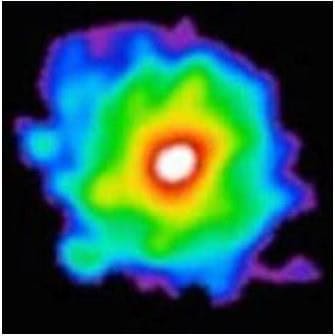Everybody became extremely excited that an advanced alien megastructure could be the reason why ‘Tabby’s Star’, known scientifically as KIC 8462852, was randomly dimming by 20% for 5 to 80 days at a time. Something deliberately made by a super hi-tech civilization could be doing this, respectable scientists suggested. Better said, researchers commented that they could not rule out an alien megastructure.
This phenomenon was spotted by the Kepler space telescope – a space observatory launched by NASA in 2009 to discover Earth-like planets orbiting stars.
However, after two weeks of pointing the Allen Telescope Array in the star’s direction, no traces of narrow-band or broad band radio signals were detected, making it more likely that whatever is causing the dimming is a natural phenomenon.
SETI researchers insist this is definitely not a ‘case closed’ for the possibility of a super-advanced alien megastructure around Tabby’s Star. But it does make a wafer thin chance of aliens being there thinner still.
 Could a Dyson sphere be causing the dimming?
Could a Dyson sphere be causing the dimming?
In their study paper (reference below), the SETI researchers wrote:
“While the star has a rotation period of 0.88 days, the strong, aperiodic brightness dips can last from 5–80 days, and this is the first time that such behavior has been reported.”
“Although natural explanations should be favored; e.g., a constellation of comets disrupted by a passing star (Boyajian et al. 2015), or gravitational darkening of an oblate star (Galasyn 2015), it is interesting to speculate that the occluding matter might signal the presence of massive astroengineering projects constructed in the vicinity of KIC 8462582.”
Could it be a Dyson swarm?
If an astro-engineering project – an engineering structure at least the size of a planet – was making the star go dimmer, it may have been a Dyson swarm of solar panels, some kind of artificial mega-sized space habitat, or even a giant beacon sending signals to other civilizations in the Universe, some researchers believed.
Freeman John Dyson (born: 1923), a British-born American mathematician and theoretical physicist, once said:
“One should expect that, within a few thousand years of its entering the stage of industrial development, any intelligent species should be found occupying an artificial biosphere which completely surrounds its parent star.”
A Dyson swarm, also known as a Dyson sphere, is a ring or series of rings surrounding a star that captures its energy.
Allen Telescope Array
The Allen Telescope Array consists of 43 antennas, each one of them 6 meters (19.7 feet) across, located at the Hat Creek Radio Observatory in the Cascade Mountains, 500 kilometers (290 miles) northeast of San Francisco, California.
 Tabbys Star (KIC 8462852) is 454 parsecs or 1,480 light years from Earth. (Image: twitter.com/tabbysstar)
Tabbys Star (KIC 8462852) is 454 parsecs or 1,480 light years from Earth. (Image: twitter.com/tabbysstar)
SETI scientists pointed the Allen Telescope Array at Tabby’s Star for over two weeks. They were trying to detect two possible types of radio signals:
– Narrow-Band Signals: these are the type SETI scientists most commonly look out for. They are about 1 Hz in width and could be a kind of ‘hailing signal’ that an alien civilization may use to tell others it is there, i.e. announce its presence.
– Broad-Band Signals: these may be leaked out of super-advanced spacecraft that come to service the astro-engineering projects around KIC 8462852.
Dr. Gerry Harp, Director, Center for SETI Research, said:
“This is the first time we’ve used the Allen Telescope Array to look for relatively wide-band signals, a type of emission that is generally not considered in SETI searches.”
No compelling evidence of an alien megastructure
The researchers gathered and analyzed over two-weeks’ worth of Array data and were unable to find clear evidence of any type of radio signal ranging from 1 to 10 GHz. This rules out omnidirectional transmitters capable of up to ten million times Earth’s total consumption of energy.
Dr. Harp and colleagues point out that any civilization that was able to build a Dyson swarm would have access to incredible energy levels – approaching 1,027 watts. Even omnidirectional transmitters (those that send signals in all directions) would be detectable if just a tiny percentage of their energy were used for sending signals.
SETI Institute senior astronomer, Dr. Seth Shostak, said:
“The history of astronomy tells us that every time we thought we had found a phenomenon due to the activities of extraterrestrials, we were wrong. But although it’s quite likely that this star’s strange behavior is due to nature, not aliens, it’s only prudent to check such things out.”
SETI says it plans to continue monitoring Tabby’s Star and its vicinity, which is 1,480 light years from Earth.
In their study paper, the scientists concluded:
“This report represents a first survey placing upper limits on anomalous flux from KIC 8462852. We expect that this star will be the object of additional observations for years to come.”
Reference: “Radio SETI Observations of the Anomalous Star KIC 8462852,” Chris Munson, J. C. Tarter, G. R. Harp, Douglas A. Vakoch, Jon Richards and Seth Shostak. Cornell University Library. Submitted on 5 Nov 2015. arXiv:1511.01606 [astro-ph.EP].
Video – Kepler Alien Megastructure
